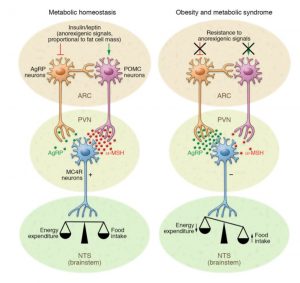
What causes obesity? The popular idea is that obesity is caused by over-eating and not exercising. But why does this happen? Why do people over-eat? The exact answer to that question is unknown.
To understand why people over-eat we must first understand how normal eating works. Two important factors involved in mediating appetite are insulin and leptin. In normal metabolic homeostasis, insulin and leptin activate POMC neurons and inhibit AgRP neurons. POMC neurons are involved in satiety, while AgRP neurons are involved in eating. This leads to a balance in energy expenditure and food intake.
There are several other peptides released by the gastrointestinal system that are involved in satiety. The first factor identified was cholecystokinin (CCK). This peptide is responsible for decreasing meal size. Glucagon-like peptide (GLP) is another peptide released from this intestine in response to meals. In rodent models, GLP-1 was shown to be involved in decreasing food intake. Peptide YY (PYY) is secreted along side GLP-1 and has similar affects. One peptide, Ghrelin, is released from the stomach and is involved in stimulating appetite.
In obesity and metabolic syndrome, there is a resistance to anorexigenic signals from insulin and leptin. This means there is no activation of POMC neurons and no inhibition of AgRP neurons. This causes a decrease in energy expenditure and an increase in food intake.

A deeper question to ask is what causes resistance to leptin and insulin?
Several mechanisms for leptin resistance have been identified including gene mutation, altered transportation across the blood brain barrier (BBB), and inflammation. Though it is extremely rare, it is possible to inherit leptin resistance. This is caused by mutations in the OB and DBU genes. However, these mutations are very rare and cause hyperphagia, obesity soon after birth, and hypothalamic hypogonadism. Because it is so rare to find these mutations in the leptin gene or its receptor, this is not the main factor for the development of leptin resistance. A factor that does play a role is altered transport of leptin across the blood brain barrier. Leptin resistance at the BBB allows for unregulated transport of leptin from the blood to the brain. Excessive levels of leptin in the blood cause a decrease in BBB permeability. Another factor that plays a part in leptin resistance is inflammation. High-fat diets can induce low-grade inflammation in tissues such as adipose tissue and the liver, which can lead to an increase in inflammatory cytokines such as IL-6 and TNF-α. Leptin is also a proinflammatory cytokine in a family similar to IL-6.
Insulin resistance is also due to many factors including genetics, aging, and ethnicity. However, the biggest factors behind insulin resistance include excess body weight and lack of exercise. With insulin resistance, cells in muscles, fat, and liver can’t respond to insulin and therefore can’t allow glucose to enter the cells.
In conclusion, insulin and leptin resistance can lead to a variety of problems. One of those problems is the inability to activate POMC neurons and inhibit AgRP neurons. This leads to no feelings of satiety, decreased energy expenditure, and an increase in food intake. Eventually, this can lead to problems such as obesity and metabolic syndrome.
References:
https://www.ncbi.nlm.nih.gov/pmc/articles/PMC2710609/
https://www.ncbi.nlm.nih.gov/pmc/articles/PMC6354688/
https://www.endocrineweb.com/conditions/type-2-diabetes/insulin-resistance-causes-symptoms
Image sources:
https://www.the-scientist.com/features/breaking-the-cancer-obesity-link-34583